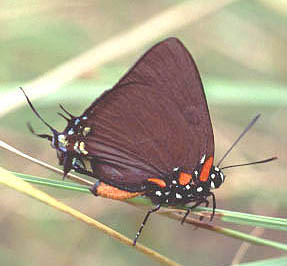
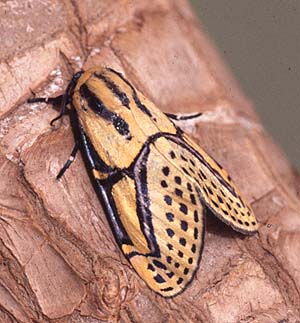
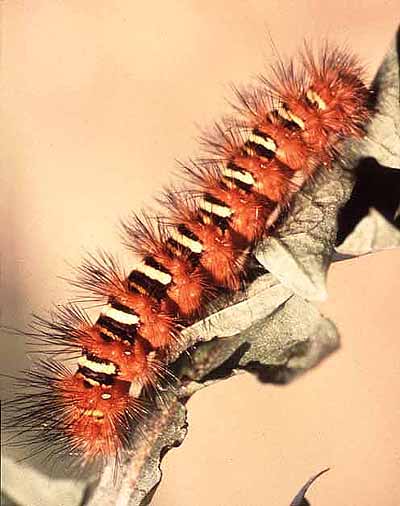
Great Purple Hairstreak (Atlides halesus) Hieroglyphic Moth (Diphthera festiva) Larva of Echo Moth (Seirarctia echo)
James K. Adams, Dept. of Natural Science, Dalton State College, Dalton, GA



Great Purple Hairstreak (Atlides halesus) Hieroglyphic Moth (Diphthera festiva) Larva of Echo Moth (Seirarctia
echo)
Last revised: Thursday, March 11, 2021.
Date of Origination: February 5, 2001.
___________________________
If you want to go directly to the list of families/species and pictures click HERE.
If you don't know precisely what you are looking for and need help, click HERE.
Pictures of Georgia's two endemic (only found in Georgia) moths:
a cute, day-flying inchworm moth,
Fernaldella
georgiana, from Ohoopee Dunes and Alligator Creek WMA.
a recently described member of the genus Sympistis,
Sympistis eleaner, from
Sapelo Island (named after my mother).
If you have any questions and want to contact me, do so at jadams@daltonstate.edu
___________________________
CLAIMER: I have attempted to design this site to be useful for just about everyone, from the novice to the researcher.
DISCLAIMERS: All mistakes in nomenclature, etc. on this site are mine, if not directly then indirectly through lack of appropriate editing. All pictures are not enlarged to the same scale; I will be adding size information to the pictures, though this may take a bit of time.
[If you are a novice, visiting for the first time and/or not particularly knowledgeable about family names, don't get freaked out if the recent updates section seems completely Greek to you!! Skip it and read on.]
[RECENT UPDATES -- The classification of
MANY Lepidoptera have been updated significantly since my last update.
With these updates, the Moths of North America Checklist (Hodges, 1983) numbers
have become completely outdated. A much more recent publication, namely
Pohl, G.R., Patterson, B., & Pelham, J.P.
2016.
Annotated taxonomic checklist of the Lepidoptera of
North America, North of Mexico. Working paper published online by the
authors
at ResearchGate.net.
766
pp., has all of the updates (except for the past five years, of
course). The new numbering system from this resource has been adopted
here, and on the pages you will see the column number listed as "P3#".]
New images of many new state records have been or are being added.]
____________________
Some terms that you will see on this website that are useful to know:
If you've got a question about butterflies and moths (Macrolepidoptera) from the state of Georgia, or for that matter, from the southeastern United States, you've come to the right place (hopefully)! The major intent of this site is to help you with identification of moths that you may find in the state of Georgia, as well as the neighboring states of Alabama, Tennessee, North Carolina, South Carolina, and (northern) Florida. Currently, this site has reasonable representation of some butterfly families (Papilionidae, Lycaenidae, Nymphalidae) as well, though some of the websites links on the links page have much more complete coverage. This site is going to be under constant modification and enhancement, but currently the site includes a hypothetical list of Lepidoptera of Georgia from all families (including micros), and over 1000 pictures of macromoths and some of their larvae. Among the pictures are many species that you may not find pictured in readily available field guides, or, for that matter, in some of the other books that are available. More and more pictures will be added as the months pass.
I have also included several links that may be helpful in your search for information on Lepidoptera, not just of the southeastern U.S., but elsewhere as well. There are numerous books, and several other websites that cover the butterflies pretty well. So, even if you can't find what you are looking for here, you hopefully can find it on some other linked site.
Pages available on this website:
Pictorial representation on this website:
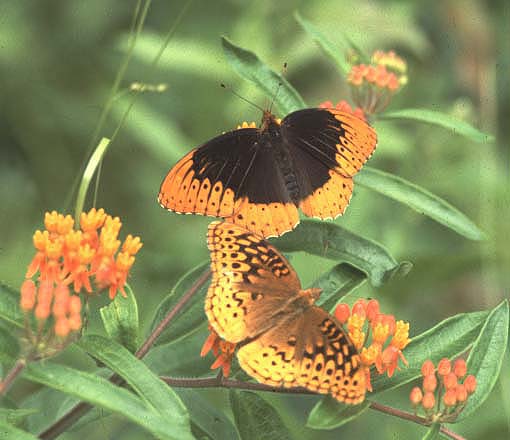
Male Diana and Great-Spangled Fritillaries (Speyeria diana and cybele) visiting Butterfly Weed (or Butterfly Milkweed -- Asclepias tuberosa) near Cooper's Creek, Union/Fannin Cos. © James Adams, 2000.
I'll repeat the disclaimer from above. The pictures presented here are not all to scale. I'll be working on putting measurement information with the pictures, but this may take a while. Please be aware of this when you are comparing a specimen of yours with the pictures.
If you are a beginner, the following paragraph may not mean much to you. Don't worry about it; I inserted the paragraph here so that people who are in a hurry and sort of know what they're looking for know what to expect when they want to look at the pictures. Read on.
There are very few micros in any family pictured here currently, though there is a smattering of representation for several families. The Carpenterworm Moths (Cossidae) and thyridids (Thyrididae) are all pictured, and the only Ghost Moth (Hepialidae) known from Georgia is pictured as well. The zygaenoids (Zygaenidae, Limacodidae, Megalopygidae, and Epipyropidae) are very well represented, with only a few limacodids missing. In the macros, the small families of the lasiocampids, saturniids, drepanids, epiplemids are virtually completely represented. The butterflies, sphingids, geometroids, and the noctuoids are pretty well represented, but there are significant gaps in portions of the geometrids, notodontids and the noctuids. The arctiids (Tiger Moths) have good photographic representation. Within the noctuids, there is decent representation in the Catocalinae (particularly the genus Zale) and a couple of other subfamilies, and almost complete representation in other subfamilies/tribes, such as the Xylenini, "Apameinae" (sensu lato), Agaristinae and Psaphidinae. In the butterflies, the Nymphalidae (Brush-Footed Butterflies) and Papilionidae (Swallowtails) are covered very well. There are several pictures for the Lycaenidae (Blues and Hairstreaks) and the Pieridae (Sulphurs and Whites), and just a smattering of Skipper pictures (Hesperiidae).
The Hypothetical List of Georgia Lepidoptera -- the List Page
I would like to claim responsibility for assembling this list, but I can't. The vast majority of the list presented here (>90%) was originally assembled by Jim Taylor of Savannah, Georgia. For those of you familiar with the Lepidopterists' Society, you know (of) Jim as the author of the "Out of the Net" column in the Lep. Soc. Newsletter. He utilized several different references, and determined from reported ranges which species should occur in the state of Georgia. I had been working in northwest Georgia on an independent macromoth list for the past ten years, and was able to add quite a few species to Jim's state list, but, as already indicated, most of the credit goes to Jim. Also included in the list is a very generalized range for each moth as reported in the resource from which Jim originally obtained his information. There are some regional treatments of moths which do *not* contain complete range information for the species covered, and I personally have found this very frustrating. I will be updating the range information on the List Pages as time passes (updates will be indicated in red), and will be indicating on the individual species pages specific ranges within the state of Georgia. Finally, on the list pages, you will also notice that I have indicated whether or not there is a definitive record for each species from the state of Georgia, whether or not there is a larval picture included on the individual species pages, and a common name for some of the species. Any butterflies or moths that you collect in the state of Georgia that are not in the list that you would like to report should be sent to my e-mail address at: jadams@daltonstate.edu
If you are just a beginner with butterflies and moths, and don't have a clue as to where to start looking for some butterfly or moth that you have encountered, then I suggest you first go to the Helpful Hints page. This page is relatively complete, but I will not guarantee for every butterfly or moth that you will be able to find the precise group that your target bug is in. But it should get you going in the right direction for a number of the more likely encountered butterflies or moths in the state. If you are knowledgeable about your target lepidopteran, keep reading.
The nomenclature that is followed here incorporates names and generic rearrangements from many of the most recent works. Some of what is included is still controversial, and, in some cases, I have chosen not to agree with certain published changes.
I might change my mind later! In other cases, I've moved some species
based on my own findings and discussions I've have had with other people, even
though the changes haven't officially been published yet. If you notice any
nomenclatural issues that you would like to discuss with me, or misspellings of some of the names, please also bring these to my attention, again by e-mailing me
at jadams@daltonstate.edu
The Pictures/Activities with Lepidoptera and Insects
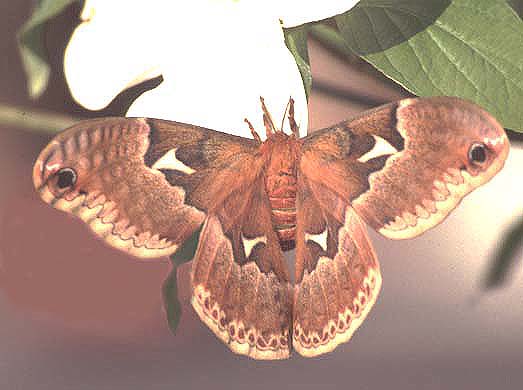
Female Tulip Tree Moth, Callosamia angulifera, © James Adams, 2001.
At the moment, the majority of the pictures included here are mine, but I will welcome donations for species not pictured here. You will notice from the acknowledgements listed below that many, many people (and the number is growing) have donated at least a few images.
There is also a set of pictures included on the unknowns page (hopefully this will remain small in number) which are also unfamiliar to me. I will be greatly appreciative to anyone with expertise visiting the site who can put names on these for me. If you can, please e-mail me.
At this point I also wish to acknowledge Mike Jordan, colleague of mine here at Dalton State College. He introduced me to Adobe Photoshop, which I have used to modify the digitized slides for inclusion here. He is also virtually wholly responsible for scanning/digitizing of the slides (we have one of those nice bulk slide scanners -- put a bunch in, press "go", come back in a little while and they're all digitized).
There are among the pictures, as you will notice, a mix of living and spread (most moth) specimens. They are somewhat variable in quality, and were digitized at lower quality for quick loading, but all should be good enough to give you a reasonably sure identification. I will be updating marginal slides as time passes. As for using mounted specimens, I do not wish to open the collecting/non-collecting debate here -- there has been plenty of discussion about this topic on more than one listserve, and it will come up again from time to time. What I do wish to do is encourage all responsible activities associated with the study of butterflies and moths. I personally do believe if you are going to become familiar with leps, particularly with the bewildering array of brown and gray moths out there, some collecting is necessary. I also feel that spread specimens, even if not in a "natural position" are still very useful for identification purposes. I also feel that, as a child, the act of collecting gave me a connection to the world of Lepidoptera I would not have developed otherwise. I enjoy doing a lot of rearing, as you may be able to tell from the larval pictures. I also strongly believe in studying butterflies and moths in their natural habitat and observing behavioral interactions -- there's a lot to still be learned out there. I also enjoy photography immensely (as you will hopefully be able to tell). I have good friends on both "sides of the fence" and will staunchly defend the right of anyone to study leps in any appropriate manner. This does not mean (over)collecting any species regardless of the circumstances.
Acknowledgements
First and foremost, I wish to acknowledge the Dalton State College Foundation, Inc., who supported the initial proposal for construction of this site. The support was through a semester of paid leave (the Foundation Award in Spring of 2000) to visit institutional collections in the state of Georgia, as well as the Smithsonian Institution in Washington, D.C., in order to obtain records and photographs of specimens from the state of Georgia that have gone and will go into this website. During the same semester, they also financially supported not only the institutional visits but collecting trips to some unique habitats in the state of Georgia that had the intent of recording some species not previously recorded from the state of Georgia, as well as documenting the existing fauna in those areas. I would also like to thank Dalton State College for housing this website on their server.
I wish to acknowledge a number of people, and if I have left someone out who should be mentioned, my sincerest apologies in advance. Again, please remind me by e-mail if I have omitted someone important.
I took circuitous expeditions around the state to several institutional collections in the Spring of 2000. I wish to thank the following people for access to the collections at the indicated institutions:
The following people have donated images/specimens/identifications:
I also wish to apologize to Dave Morgan of Atlanta, Mike Chapman of Brunswick, and Jim Flynn of Cumming for potentially stepping on their toes. They all have websites on the butterflies of Georgia (a few moths are included on Dave Morgan's site as well). Their website addresses are listed on the links page in the Butterfly Sites.
I additionally want to acknowledge both my parents-in-law (Billy and Patsy Parker) and grandparents-in-law (Austin and Bonnell Fowler) for giving me free reign to collect moths on their property. The Fowlers' property (east of Fairmount in NE Bartow Co.) is particularly interesting, with fallow pasture, wooded hillside, cane-brake and wetland microhabitats which harbor all sorts of interesting and uncommon moths. I also wish to acknowledge the Collins of Sonoraville, Gordon Co., for allowing me access to cane habitats on their property as well. And finally, I also wish to extend my thanks to Ed and Glenda Williams of Calhoun, GA. They, too, have graciously allowed me to sample their extensive cane and other habitats along the Oostanaula river, just twelve minutes from my house. I added several noctuids and a geometrid to the GA list from their property during the 2002 season.